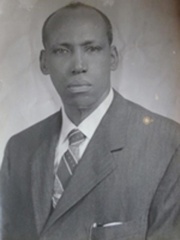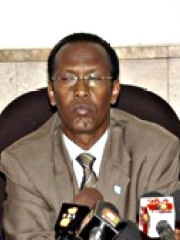

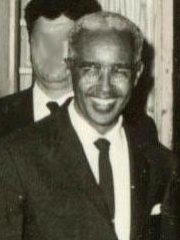

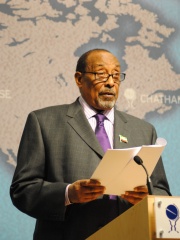



The Most Famous
POLITICIANS from Somalia
This page contains a list of the greatest Somali Politicians. The pantheon dataset contains 19,576 Politicians, 33 of which were born in Somalia. This makes Somalia the birth place of the 86th most number of Politicians behind Ethiopia, and Uzbekistan.
Top 10
The following people are considered by Pantheon to be the top 10 most legendary Somali Politicians of all time. This list of famous Somali Politicians is sorted by HPI (Historical Popularity Index), a metric that aggregates information on a biography's online popularity. Visit the rankings page to view the entire list of Somali Politicians.

1. Siad Barre (1919 - 1995)
With an HPI of 78.86, Siad Barre is the most famous Somali Politician. His biography has been translated into 51 different languages on wikipedia.
Mohammed Siad Barre (Somali: Maxamed Siyaad Barre; Arabic: محمد زياد بري, romanized: Muhammad Ziād Barīy; c. 6 October 1919 – 2 January 1995) was a Somali military officer, politician, and revolutionary who served as the third president of Somalia from 21 October 1969 to 26 January 1991. Barre, the commander of the Somali National Army, became president of Somalia after the 1969 coup d'état that overthrew the Somali Republic following the assassination of President Abdirashid Shermarke. The Supreme Revolutionary Council military junta under Barre reconstituted Somalia as a one-party Marxist–Leninist communist state, renamed the country the Somali Democratic Republic and adopted scientific socialism. Barre spoke three languages, English, Somali and Italian. Barre's early rule was characterised by attempts at widespread modernization, nationalization of banks and industry, promotion of cooperative farms, a new writing system for the Somali language, and anti-tribalism. In 1976, the Somali Revolutionary Socialist Party became the country's vanguard party. The following year Barre launched the Ogaden War against Ethiopia's Derg regime, supporting the Western Somali Liberation Front on a platform of Somali nationalism and pan-Somalism. Barre's popularity was highest during the seven months between September 1977 and March 1978 when Barre captured virtually the entirety of the Somali region. It declined from the late-1970s following Somalia's defeat in the Ogaden War, triggering the Somali Rebellion and severing ties with the Soviet Union. Somalia then allied itself with the Western powers and especially the United States for the remainder of the Cold War, although it maintained its Marxist–Leninist regime and also drew close to China. Opposition grew in the 1980s due to his increasingly dictatorial rule, growth of tribal politics, abuses of the National Security Service including the Isaaq genocide, and the sharp decline of Somalia's economy. In 1991, Barre's government collapsed as the Somali Rebellion successfully ejected him from power, leading to the Somali Civil War and a massive power vacuum in its wake. Barre was forced into exile in Nigeria, where he died in 1995 on the way to the hospital after suffering a heart attack.

2. Hassan Sheikh Mohamud (b. 1955)
With an HPI of 73.56, Hassan Sheikh Mohamud is the 2nd most famous Somali Politician. His biography has been translated into 49 different languages.
Hassan Sheikh Mohamud (born 29 November 1955) is a Somali politician serving as the president of Somalia since 15 May 2022. He previously held the office from 2012 to 2017. Hassan was previously a university professor and dean at SIMAD University, which he co-founded. During 2012 he was elected President of the Transitional Federal Government (TFG). Time magazine placed him on an annual list of the 100 most influential people in the world in 2013. During 2014 he controversially welcomed the entry of Ethiopian troops into the African Union mission in the wake of the 2006 invasion. His first administration faced serious criticism for rampant corruption, media restrictions and abuse of power. After losing power in 2017, he became the founder and current chairman of the Union for Peace and Development Party. He was indirectly elected as President of the Federal Republic of Somalia on 15 May 2022.

3. Aden Adde (1908 - 2007)
With an HPI of 71.73, Aden Adde is the 3rd most famous Somali Politician. His biography has been translated into 43 different languages.
Aden Abdulle Osman Da’ar (Somali: Aadan Cabdulle Cismaan Dacar, Arabic: آدم عبد الله عثمان دعر) (9 December 1908 – 8 June 2007), popularly known as Aden Adde, was a Somali politician who served as the first president of the Somali Republic from 1 July 1960 to 6 July 1967. He had previously served in the Somali Youth League in 1944. In 1946, he was named Secretary of the party's section in Beledweyne, Somali Republic. In 1951, the Mudug Regional Council appointed him for the Regional Council, and two years later, he became Vice President of the Regional Council. From 1954 until 1956, he was the President of the Somali Youth League. He was re-elected in May 1958, and he continued to hold this position simultaneously along with that of Speaker of the Legislative Assembly until 1960. Osman Daar was born in Beledweyne, Somali Republic. He studied at government schools, and worked as a community organizer. Somalia was colonized by the Italian government from 1889 to 1941. From 1929 to 1941, he served in the Italian Colonial Administration advocating for Somalia's independence from colonization. He was a proponent for the unity of all Somalis. In 1960, Osman Daar garnered national attention, and won the favor of the Somali people. He was formally and democratically elected as the first president of the Somali Republic on 1 July 1960, on which date the United Nations recognised Somalia's independence, and subsequently united with the former British protectorate of British Somaliland, which had already obtained its independence on 26 June 1960. His administration was focused on dismantling the legacy of colonialism and fostering unity among the Somali people.

4. Abdirashid Shermarke (1919 - 1969)
With an HPI of 69.06, Abdirashid Shermarke is the 4th most famous Somali Politician. His biography has been translated into 29 different languages.
Abdirashid Ali Sharmarke (Somali: Cabdirashiid Cali Sharmaarke, Arabic: عبد الرشيد علي شرماركي) (8 June 1919 – 15 October 1969), was the first Prime Minister of the Somali Republic from 12 July 1960 to 14 June 1964 and the second President from 6 July 1967, until his assassination on October 15, 1969.
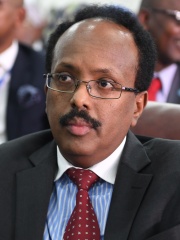
5. Mohamed Abdullahi Mohamed (b. 1962)
With an HPI of 68.77, Mohamed Abdullahi Mohamed is the 5th most famous Somali Politician. His biography has been translated into 51 different languages.
Mohamed Abdullahi Mohamed (Somali: Maxamed Cabdullaahi Maxamed, born 11 March 1962), commonly known as Farmaajo, is a Somali politician and diplomat who served as the 9th President of Somalia from 2017 to 2022 and as Prime Minister from 2010 to 2011. His presidency focused on combating corruption and rebuilding the Somali National Army as part of broader state-building efforts. Since 2012, he has been the founder and leader of the Nabad iyo Nolol political party.

6. Ahmed Mohamed Mohamoud (1936 - 2024)
With an HPI of 67.62, Ahmed Mohamed Mohamoud is the 6th most famous Somali Politician. His biography has been translated into 25 different languages.
Ahmed Mohamed Mohamoud (Somali: Axmed Maxamed Maxamuud, Arabic: احمد محمد محمود; 1 June 1938 – 15 November 2024), known by his nickname Silanyo (Arabic: سيلانيو), was a Somaliland politician who served as the President of Somaliland from 2010 to 2017. During the 1980s, he served as the Chairman of the Somali National Movement. Silanyo was a long-time member of the former Somali Republic and later the Somali Democratic Republic central government. He held several key positions, including serving as Minister of Commerce of the Somali Republic. Standing as an opposition candidate, he was elected as President of Somaliland in Somaliland's 2010 presidential election.

7. Mohamed Farrah Aidid (1934 - 1996)
With an HPI of 66.46, Mohamed Farrah Aidid is the 7th most famous Somali Politician. His biography has been translated into 30 different languages.
Mohamed Farrah Hasan Garad (Somali: Maxamed Faarax Xasan Garaad, 'Caydiid Garaad' ; Arabic: محمد فرح حسن عيديد; 15 December 1934 – 1 August 1996), popularly known as General Aidid or Aideed, was a Somali military officer, diplomat, and warlord.[1]

8. Hassan Gouled Aptidon (1916 - 2006)
With an HPI of 64.68, Hassan Gouled Aptidon is the 8th most famous Somali Politician. His biography has been translated into 43 different languages.
Hassan Gouled Aptidon (Somali: Xasan Guuleed Abtidoon; Arabic: حسن جوليد أبتيدون; October 15, 1916 – November 21, 2006) was a Djiboutian politician and dictator who served as the first President of Djibouti from 1977 to 1999.

9. Mohamed Osman Jawari (1945 - 2024)
With an HPI of 62.66, Mohamed Osman Jawari is the 9th most famous Somali Politician. His biography has been translated into 19 different languages.
Mohamed Osman Jawari (Somali: Maxamed Cismaan Jawaari, Arabic: محمد عثمان جواري; 7 December 1945 – 28 June 2024), also known as Mohamed Jawari or Osman Jawari, was a Somali attorney and politician. He was Speaker of the Federal Parliament of Somalia from 2012 to 2018. He also briefly served as acting President of Somalia from August to September 2012.

10. Abdullahi Yusuf Ahmed (1934 - 2012)
With an HPI of 62.08, Abdullahi Yusuf Ahmed is the 10th most famous Somali Politician. His biography has been translated into 40 different languages.
Abdullahi Yusuf Ahmed (Somali: Cabdulaahi Yuusuf Axmed, Arabic: عبدالله يوسف أحمد; 15 December 1934 – 23 March 2012), was a Somali politician and former military official who served as the first President of Puntland from 1998 to 2004. He also played a key role in establishing the Transitional Federal Government (TFG), which he led as President of Somalia from 2004 to 2008. Additionally, he was one of the founders of the rebel Somali Salvation Democratic Front (SSDF). Yusuf was a career soldier in the Somali National Army, participating in the 1964 Border War and Ogaden War against Ethiopia. After Somalia's defeat in the Ogaden War in 1978, he led a failed coup against President Siad Barre, marking the start of the Somali rebellion. Following the coup's failure, Yusuf established the Somali Salvation Democratic Front in Ethiopia and began fighting alongside Ethiopian forces against the Somali army. During the 1982 Ethiopian-Somali War, he led SSDF forces. Frustrated by the operation's failure and the SSDF's surrender to the Somali government, the Ethiopians jailed Yusuf until the Derg regime collapsed in 1991. After his release, Yusuf returned to his home region and helped establish the Puntland government in 1998. He later joined an Ethiopian-backed coalition of warlords opposing the Somali Transitional National Government (TNG) formed in 2000. During the Puntland crisis (2001–2003) he had a violent power struggle against Jama Ali Jama over regional leadership. Yusuf attempted to extend his term after it expired, sparking a political crisis and the election of a new Puntland president, which Yusuf rejected. In May 2002, with Ethiopian military assistance, Yusuf ousted Jama after accusing him of ties to terrorism. During the conflict he was responsible for ordering the assassinations of civic leaders in Puntland such as Sultan Hurre. In 2004, Yusuf became president of the Transitional Federal Government (TFG). He received Ethiopia's backing and approval, in exchange for dropping Somalia's long-standing claim to the Ogaden region. Despite widespread opposition within the TFG and without cabinet or parliamentary approval, Yusuf controversially requested Ethiopian troops to support his administration against the Islamic Courts Union during 2006. By the end of the Ethiopian military occupation in December 2008, much of the country had fallen to the insurgency and Yusuf was sanctioned by IGAD for illegally sacking the speaker of parliament. The TFG parliament moved to impeach Yusuf after accusing him of being a dictator. On 24 December 2008, he resigned from the presidency, leading to the dissolution of his government. After he resigned he was given political asylum in Yemen. Yusuf died in Abu Dhabi the Capital city of the United Arab Emirates on 23 March 2012.
People
Pantheon has 33 people classified as Somali politicians born between 1908 and 1982. Of these 33, 16 (48.48%) of them are still alive today. The most famous living Somali politicians include Hassan Sheikh Mohamud, Mohamed Abdullahi Mohamed, and Muse Bihi Abdi. The most famous deceased Somali politicians include Siad Barre, Aden Adde, and Abdirashid Shermarke.
Living Somali Politicians
Go to all RankingsHassan Sheikh Mohamud
1955 - Present
HPI: 73.56
Mohamed Abdullahi Mohamed
1962 - Present
HPI: 68.77
Muse Bihi Abdi
1948 - Present
HPI: 61.21
Omar Sharmarke
1960 - Present
HPI: 59.23
Hassan Ali Khayre
1968 - Present
HPI: 56.90
Abdiweli Gaas
1967 - Present
HPI: 55.37
Sharif Sheikh Ahmed
1964 - Present
HPI: 54.48
Aden Madobe
1956 - Present
HPI: 54.14
Abdiweli Sheikh Ahmed
1958 - Present
HPI: 53.51
Dahir Riyale Kahin
1952 - Present
HPI: 53.39
Mohamed Hussein Roble
1963 - Present
HPI: 49.95
Edna Adan Ismail
1937 - Present
HPI: 49.63
Deceased Somali Politicians
Go to all RankingsSiad Barre
1919 - 1995
HPI: 78.86
Aden Adde
1908 - 2007
HPI: 71.73
Abdirashid Shermarke
1919 - 1969
HPI: 69.06
Ahmed Mohamed Mohamoud
1936 - 2024
HPI: 67.62
Mohamed Farrah Aidid
1934 - 1996
HPI: 66.46
Hassan Gouled Aptidon
1916 - 2006
HPI: 64.68
Mohamed Osman Jawari
1945 - 2024
HPI: 62.66
Abdullahi Yusuf Ahmed
1934 - 2012
HPI: 62.08
Sheikh Mukhtar Mohamed Hussein
1912 - 2012
HPI: 60.88
Nur Hassan Hussein
1937 - 2020
HPI: 60.14
Ali Mohammed Ghedi
1952 - Present
HPI: 59.28
Ali Mahdi Muhammad
1939 - 2021
HPI: 58.45
Overlapping Lives
Which Politicians were alive at the same time? This visualization shows the lifespans of the 16 most globally memorable Politicians since 1700.











